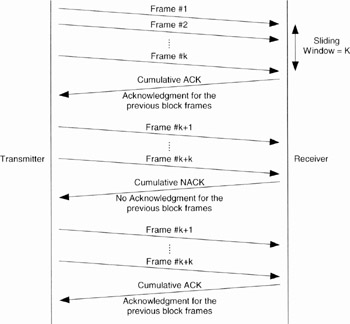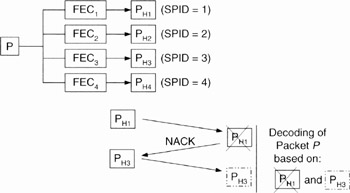8.7 Automatic Repeat Request (ARQ)
8.7 Automatic Repeat Request (ARQ)
The ARQ (Automatic Repeat reQuest) [16] is a control mechanism of data link layer where the receiver asks the transmitter to send again a block of data when errors are detected. The ARQ mechanism is based on acknowledgement (ACK) or nonacknowledgement (NACK) messages, transmitted by the receiver to the transmitter to indicate a good (ACK) or a bad (NACK) reception of the previous frames. A sliding window can be introduced to increase the transmission rate. Figure 8.9 shows the cumulative ARQ mechanism.

Figure 8.9: Illustration of the cumulative ARQ process
An ARQ block is a distinct unit of data that is carried on an ARQ-enabled connection. An ARQ block is assigned a sequence number (SN) or a Block Sequence Number (BSN) and is managed as a distinct entity by the ARQ state machines. The block size is a parameter negotiated during connection establishment.
A system supporting ARQ must then be able to receive and process the ARQ feedback messages. The ARQ feedback information can be sent as a standalone MAC management message (see Type 33 in Table 8.5) on the appropriate basic management connection or piggybacked on an existing connection. Piggybacked ARQ feedback is sent as follows: the ARQ feedback payload subheader, introduced in Section 8.2.3 (see Type 4 bit in the generic MAC frame header), can be used to send the ARQ ACK variants: cumulative, selective, selective with cumulative, cumulative with block. When sent on an appropriate basic management connection, the ARQ feedback cannot be fragmented.
The ARQ is a MAC mechanism which is optional for implementation in the 802.16 standard. When implemented, the ARQ may be enabled on a per-connection basis. The perconnection ARQ is specified and negotiated during connection creation. A connection cannot have a mixture of ARQ and non-ARQ traffic.
8.7.1 ARQ Feedback Format
The Standalone ARQ Feedback message can be used (in addition to piggybacking ARQ) to signal any combination of different ARQ ACKs: cumulative, selective and selective with cumulative. Table 8.8 shows the ARQ Feedback Information Element (IE) used by the receiver of an ARQ block to signal positive or negative acknowledgments. The ACK map is a field where each bit indicates the status (received correctly or not) of the referred ARQ block.
| Field | Size | Notes |
|---|---|---|
| CID | 16 bits | The ID of the connection being referenced |
| Last | 1 bits | 0 = more ARQ feedback IE in the list; 1 = last ARQ feedback IE in the list |
| ACK Type | 2 bits | 0×0 = Selective ACK entry, 0×1 = cumulative ACK entry, 0×2 = cumulative with selective ACK entry, 0×3 = cumulative ACK with a block sequence ACK entry |
| BSN (Block Sequence Number) | 11 bits | The definition of this field is a function of ACK Type. For cumulative ACK, the BSN value indicates that its corresponding block and all blocks with lesser values within the transmission window have been successfully received |
| Number of ACK maps | 2 bits | If ACK Type = 01, the field is reserved and set to 00. Otherwise this field indicates the number of ACK maps: 0×0 = 1, 0×1 = 2, 0×2 = 3 and 0×3 = 4 |
| (For selective ACK types) one or more selective ACK Maps | 16 bits per ACK map | Each bit set to one indicates that the corresponding ARQ block has been received without errors. The bit corresponding to the BSN value in the IE is the most significant bit of the first map entry |
If ACK Type=0 x 1 (cumulative ARQ), the BSN value indicates that its corresponding block and all blocks with lesser values within the transmission window have been successfully received. Figure 8.9 represents the cumulative ACK ARQ mechanism.
8.7.1.1 Selective ACK and Cumulative with Selective ACK
Each bit set to one in the selective ACK MAP indicates that the corresponding ARQ block has been received without errors. The bit corresponding to the BSN value in the ARQ Feedback Information IE is the most significant bit of the first map entry. The bits for succeeding block numbers are assigned left-to-right (MSB to LSB) within the map entry.
Cumulative with selective ACK associates cumulative and selective mechanisms: ACKnowledgement is made for a number of ARQ blocks.
8.7.1.2 ARQ and Packing or Fragmentation
The ARQ mechanism may be applied to fragmented MAC SDUs or to packed MAC PDUs. In this case, the Extended Type bit in the generic MAC header must be set to 1 (see Section 8.2).
8.7.2 Hybrid Automatic Repeat Request (HARQ) Mechanism
The Hybrid ARQ (HARQ) mechanism uses an error control code in addition to the retransmission scheme to ensure a more reliable transmission of data packets (relative to ARQ). The main difference between an ARQ scheme and an HARQ scheme is that in HARQ, subsequent retransmissions are combined with the previous erroneously received transmissions in order to improve reliability. HARQ parameters are specified and negotiated during the initialisation procedure. A burst cannot have a mixture of HARQ and non-HARQ traffic. The HARQ scheme is an optional part of the 802.16 standard MAC. HARQ may only be supported by the OFDMA PHYsical interface.
For the downlink HARQ, a fast ACK/NACK exchange is needed. Uplink slots ACK (ULACK) in the OFDMA frame allow this fast feedback (see the OFDMA frame in Chapter 9).
Two main variants of HARQ are supported:
-
Incremental Redundancy (IR) for CTC and CC. The PHY layer encodes the HARQ packet generating several versions of encoded subpackets (see Figure 8.10). Each subpacket is uniquely identified by a SubPacket IDentifier (SPID). Four subpackets can be generated for a packet to be encoded. For each retransmission the coded block (the SPID) is different from the previously transmitted coded block.

Figure 8.10: Incremental Redundancy (IR) HARQ -
Chase Combining (CC) for all coding schemes. The retransmission is identical to the initial transmitted block. The PHY layer encodes the HARQ packet generating only one version of the encoded packet (no SPID is required).
An SS may support IR and an SS may support either CC or IR.
[16]Johnston, D. and Yaghoobi, H., Peering into the WiMAX spec, CommsDesign (http://www.commsdesign.com/), January 2004.
EAN: 2147483647
Pages: 124